Yes, good point. The glow from the furnace can cast a shadow and cause a false reading. The ancient Greeks did have water clocks (? I think? if I recall correctly?) but that may not be a good choice around heat and electricity either.The sun dial is not as accurate as I would like to be either.
You are using an out of date browser. It may not display this or other websites correctly.
You should upgrade or use an alternative browser.
You should upgrade or use an alternative browser.
Small Heat Treat Oven
- Thread starter Brian Rupnow
- Start date

Help Support Home Model Engine Machinist Forum:
This site may earn a commission from merchant affiliate
links, including eBay, Amazon, and others.
I scanned my instructions and they all came up as .pdf files and I can't upload them. so, being Mr. Resourceful, I took pictures of them with my camera because it saves them as .jpeg and I can post them. I will be very grateful for any help.---Brian
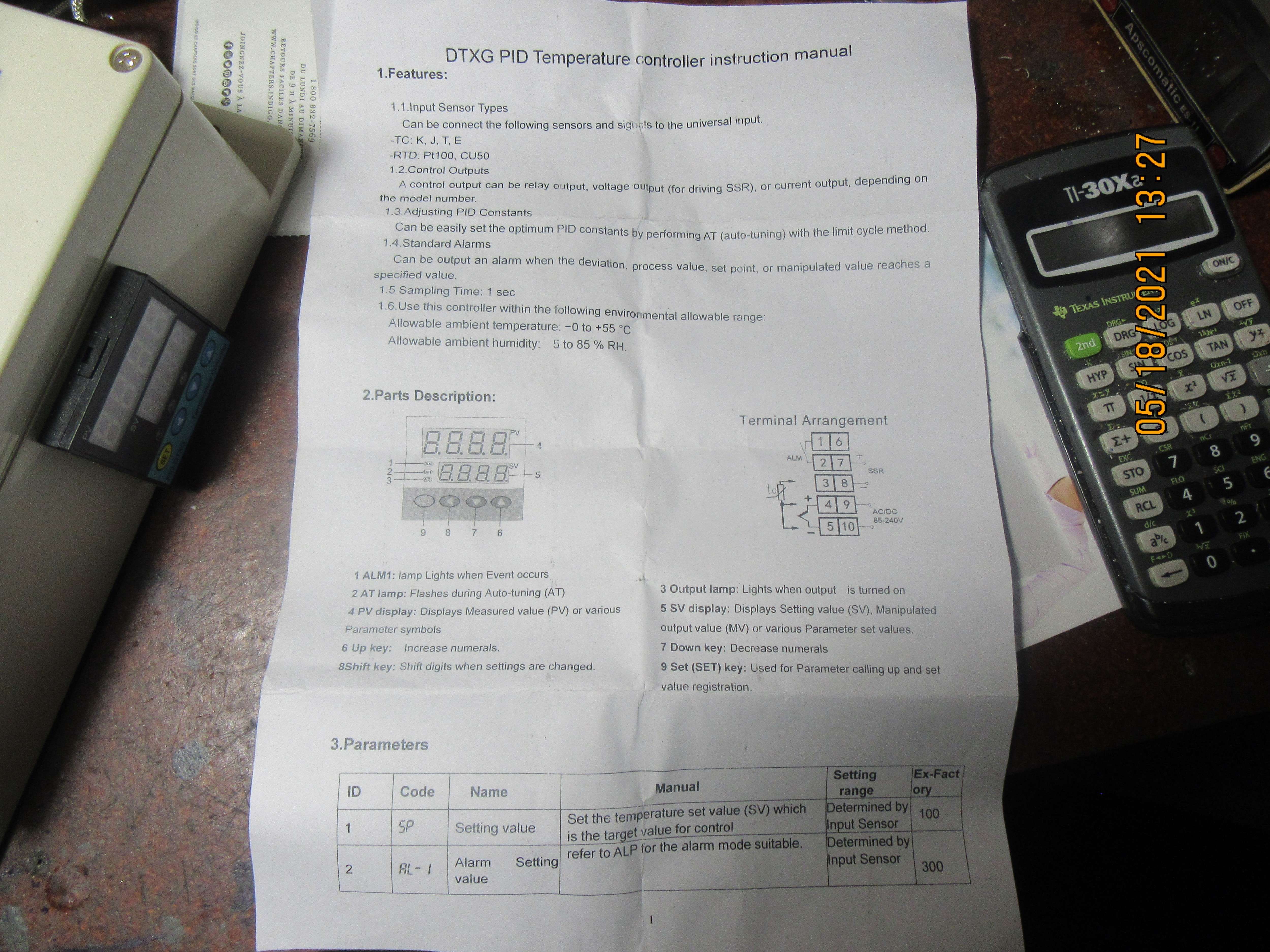
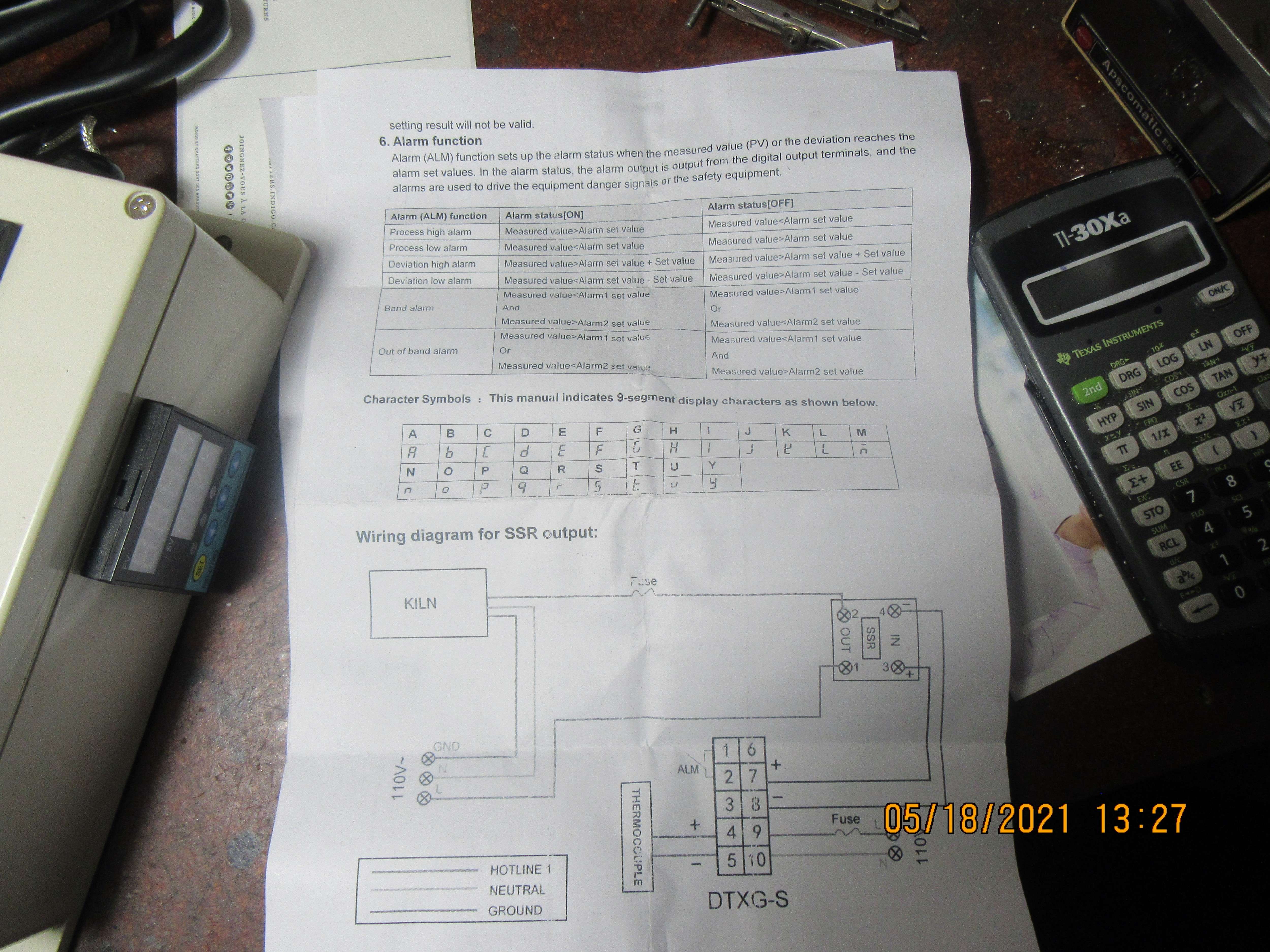
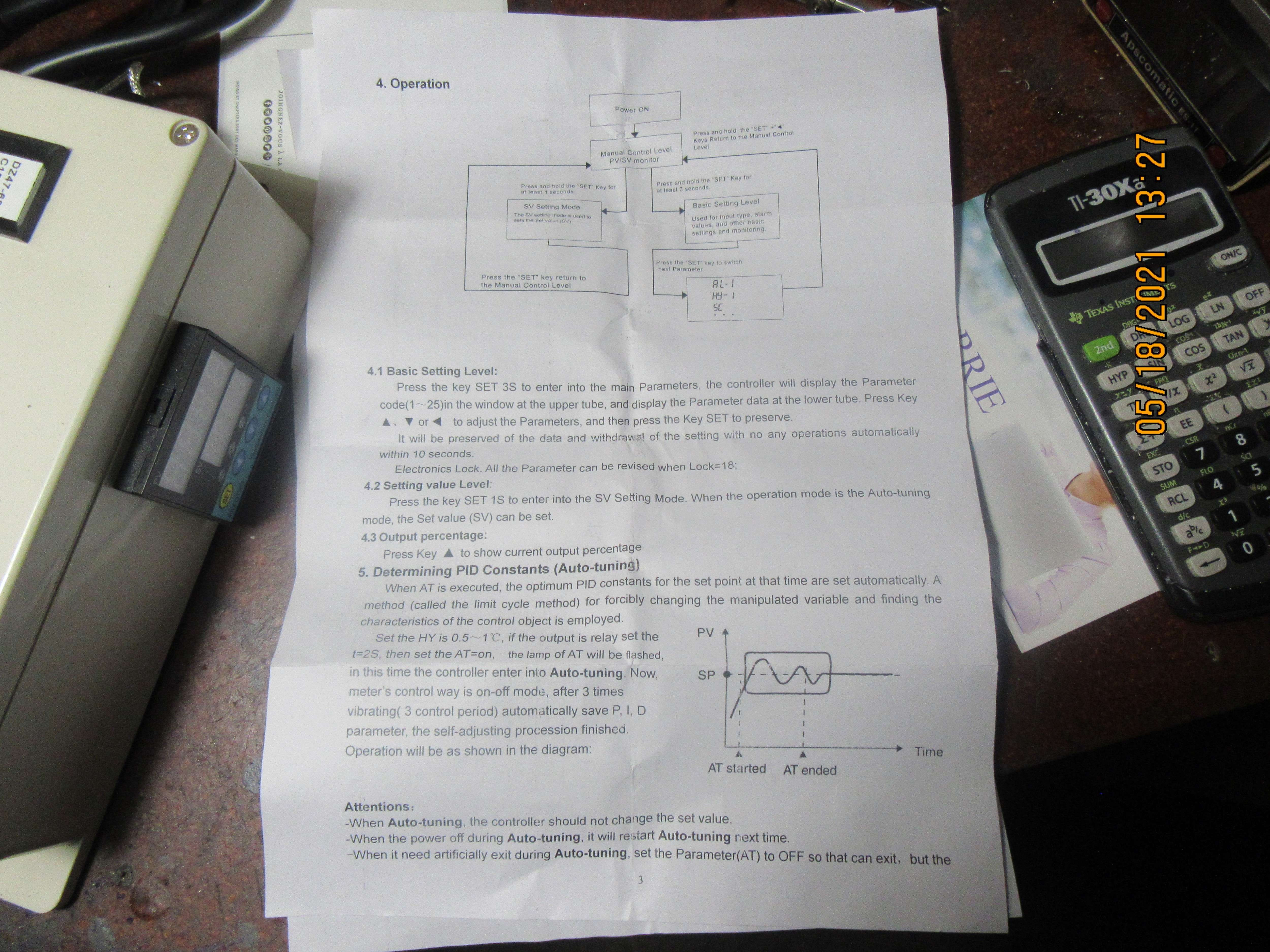
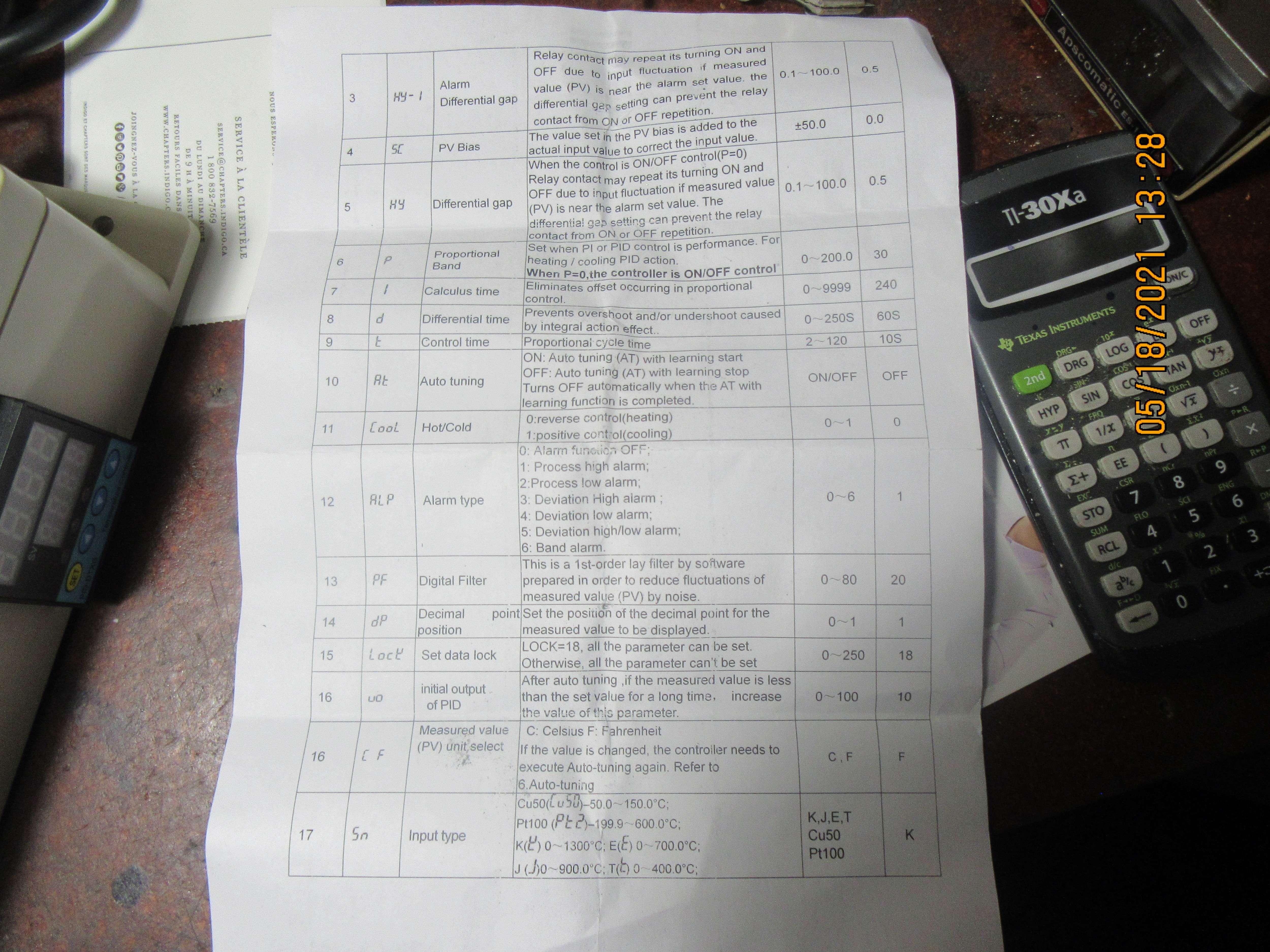




HennieL
Well-Known Member
OK Brian, I see it's called a "DTXG" - Google gave me access to sites where I downloaded the same instruction manual, and a second Word document with some more info. Please send me your email address (PM me...) and I will forward them to you.
It's getting quite late here in my nick of the woods, and I must have an early start tomorrow morning, but I will try to read up on the documents through the day tomorrow, and see if I can help you tomorrow evening (SA time - say an hours before the time of this post...).
One quick thing that I can note now, is that this unit does differ slightly in setting the required temperature - according to the operator's manual one must push the "Set" button for a short period (not more than probably one second) in order to enter the "SV setting mode". Then, it's as I suggested earlier - push the sideways arrow to jump between the various digits (i.e. the "ones", "tens" "hundreds" and the "thousands". On each of these digits, push either the "up" or "down" arrows to change that digit's value, and then push the sideways arrow again to move to the next digit. Once your temperature is set, push the "SET" button again to store that value and start the oven.
Don't push the "SET" button for more than a short push, though - keeping it pushed for more than 3 seconds will cause the unit to enter it's "Program" mode, and we don't want to go there yet. If it does enter the program mode, don't panic, though - just leave it be (do nothing) and it will revert back to it's normal mode in about 10 seconds or so.
Hope is is of some help in the meantime...
Hennie
It's getting quite late here in my nick of the woods, and I must have an early start tomorrow morning, but I will try to read up on the documents through the day tomorrow, and see if I can help you tomorrow evening (SA time - say an hours before the time of this post...).
One quick thing that I can note now, is that this unit does differ slightly in setting the required temperature - according to the operator's manual one must push the "Set" button for a short period (not more than probably one second) in order to enter the "SV setting mode". Then, it's as I suggested earlier - push the sideways arrow to jump between the various digits (i.e. the "ones", "tens" "hundreds" and the "thousands". On each of these digits, push either the "up" or "down" arrows to change that digit's value, and then push the sideways arrow again to move to the next digit. Once your temperature is set, push the "SET" button again to store that value and start the oven.
Don't push the "SET" button for more than a short push, though - keeping it pushed for more than 3 seconds will cause the unit to enter it's "Program" mode, and we don't want to go there yet. If it does enter the program mode, don't panic, though - just leave it be (do nothing) and it will revert back to it's normal mode in about 10 seconds or so.
Hope is is of some help in the meantime...
Hennie
Hennie---My email is [email protected] Thank you.---Brian
If you look at the lower left corner of the frame I built, down by the air compressor tank, there are two screws going into the "baseboard". My knees have got so bad that there was just no way to get down on my knees in that corner to put the screws in. I have "gell" kneepads, but my knees are basically "bone on bone" now, and it just hurts to much too get down on them. Damn, getting old isn't much fun. Anyways, our 42 year old son came over for supper tonight and brought his battery powered screwdriver and put the two screws in for me. I still have to grind away a little bit of weld inside the oven holding bracket so the oven sets level, and then it will be on to the oven and controller.
My heat treat oven has a round hole in the door (see post #8 for picture). I assume that is where the temperature testing probe connects to tell the controller how hot it is inside. that seems to me to be very inconvenient. Can I put a new hole in thru the side of the oven and mount the probe permanently in the side? What can I use to plug the hole in the door?---Brian

$54.46
Amana Tool - 46280 CNC 2D & 3D Carving 6.2 Deg Tapered Angle Ball Tip x 1/32 Dia x 1/64
Express Tool Supply
![DreamPlan Home Design and Landscaping Software Free for Windows [PC Download]](https://m.media-amazon.com/images/I/51kvZH2dVLL._SL500_.jpg)
$0.00
DreamPlan Home Design and Landscaping Software Free for Windows [PC Download]
Amazon.com Services LLC

$45.99
Sunnytech Mini Hot Air Stirling Engine Motor Model Educational Toy Kits Electricity HA001
stirlingtechonline

$519.19
$699.00
FoxAlien Masuter Pro CNC Router Machine, Upgraded 3-Axis Engraving All-Metal Milling Machine for Wood Acrylic MDF Nylon Carving Cutting
FoxAlien Official

$443.98
TM NEXDYNAMI AT29618 Water Pump Compatible With/Replacement For John Deere 1020 1520 2020 300 301 400 401 440 440A 480 AT29618
VIVID MARKET CORPORATION

$40.02
$49.99
Becker CAD 12 3D - professional CAD software for 2D + 3D design and modelling - for 3 PCs - 100% compatible with AutoCAD
momox Shop

$109.99
AmTech300 - Boiler Treatment Professional Strength (Rust Inhibitor For Outdoor Wood Boilers)
Alternative Heating & Supplies

$99.99
AHS Outdoor Wood Boiler Yearly Maintenance Kit with Water Treatment - ProTech 300 & Test Kit
Alternative Heating & Supplies

$156.90 ($1.40 / oz)
Replacement Combustion Chamber Kit, Burnham V8 and V8H, 1-6 Sec, 108136-01, 1129
Lynn Manufacturing

$39.99
$49.99
Sunnytech Low Temperature Stirling Engine Motor Steam Heat Education Model Toy Kit For mechanical skills (LT001)
stirlingtechonline
HennieL
Well-Known Member
I don't see any reason why you would want a probe through the door... I would install it through the back of the oven (presuming there are no heating elements in the back). The refractory material might be brittle and crack, but hopefully if you just go slowly and use a concrete bit you could do it without serious problems.My heat treat oven has a round hole in the door (see post #8 for picture). I assume that is where the temperature testing probe connects to tell the controller how hot it is inside. that seems to me to be very inconvenient. Can I put a new hole in thru the side of the oven and mount the probe permanently in the side? What can I use to plug the hole in the door?---Brian
Does your probe have a sheath? Probes also need to be protected from oxidation at high heat, and it is normal to install the probe inside a ceramic or stainless steel sheath that screws air-tight onto the probe. these sheaths normally come with some kind of mounting bracket, and that would dictate the position that is must be mounted in/on your oven - see below:


- Joined
- Jan 4, 2011
- Messages
- 1,432
- Reaction score
- 401
My oven has the probe through the top rear of the oven. The refractory material is pretty soft and easy to drill. Just go slow and make sure that it is not through one of the heater elements. If you go through the hole in the front you will be flexing the leads every time you open the door and they will soon break.
The heat treat oven is in it's final home position. I drilled thru the side of the oven near the top, for the thermocouple, not interfering with the heating coils, about 4" in from the front (the oven is 8 1/2" deep.). I have power to the controller and the oven is heating up and the digital display on the controller is lit up. I have to put a new 3 wire lead on the oven, as it only had a two wire lead and plug on the cord, with no ground. I went down town this morning trying to find a length of 3 wire heat resistant cord, but all the businesses are shut down for covid. I'm happy with what I have here, and hopefully will be even happier when I get the controller figured out. This oven has the cheesiest hinges ever, I think they are made form #20 gauge steel, so I will fabricate new hinges for each side of the door.
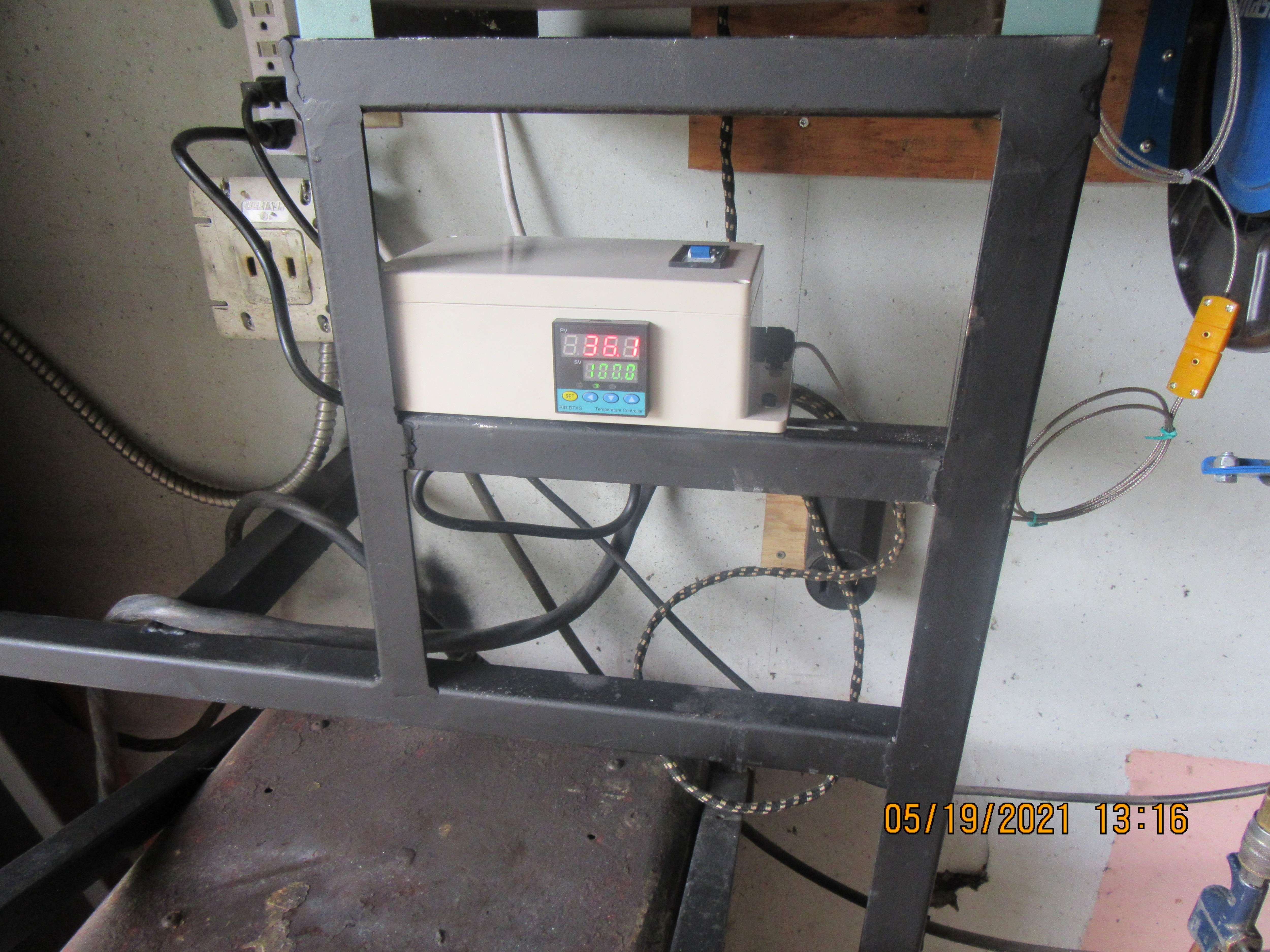
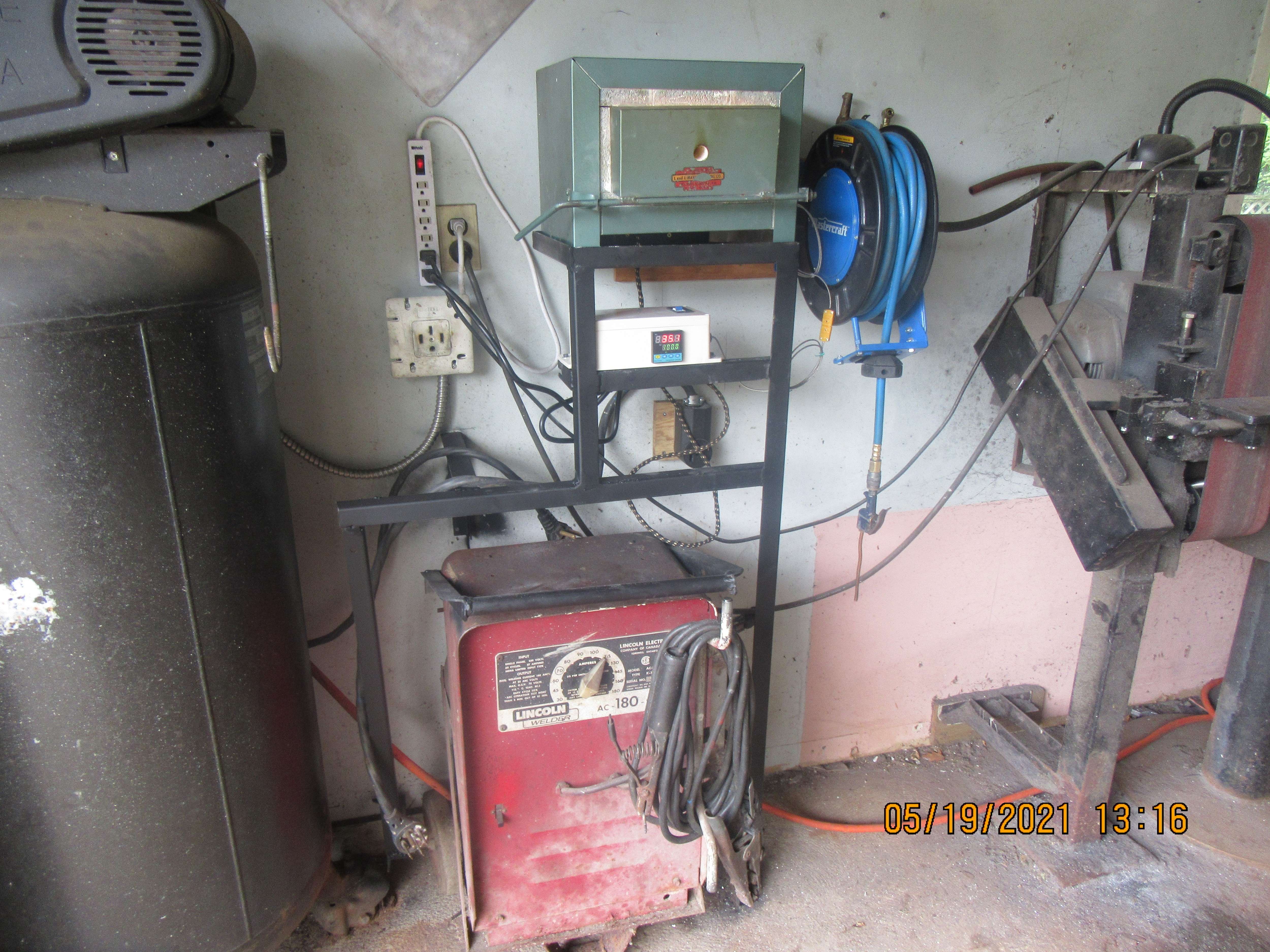
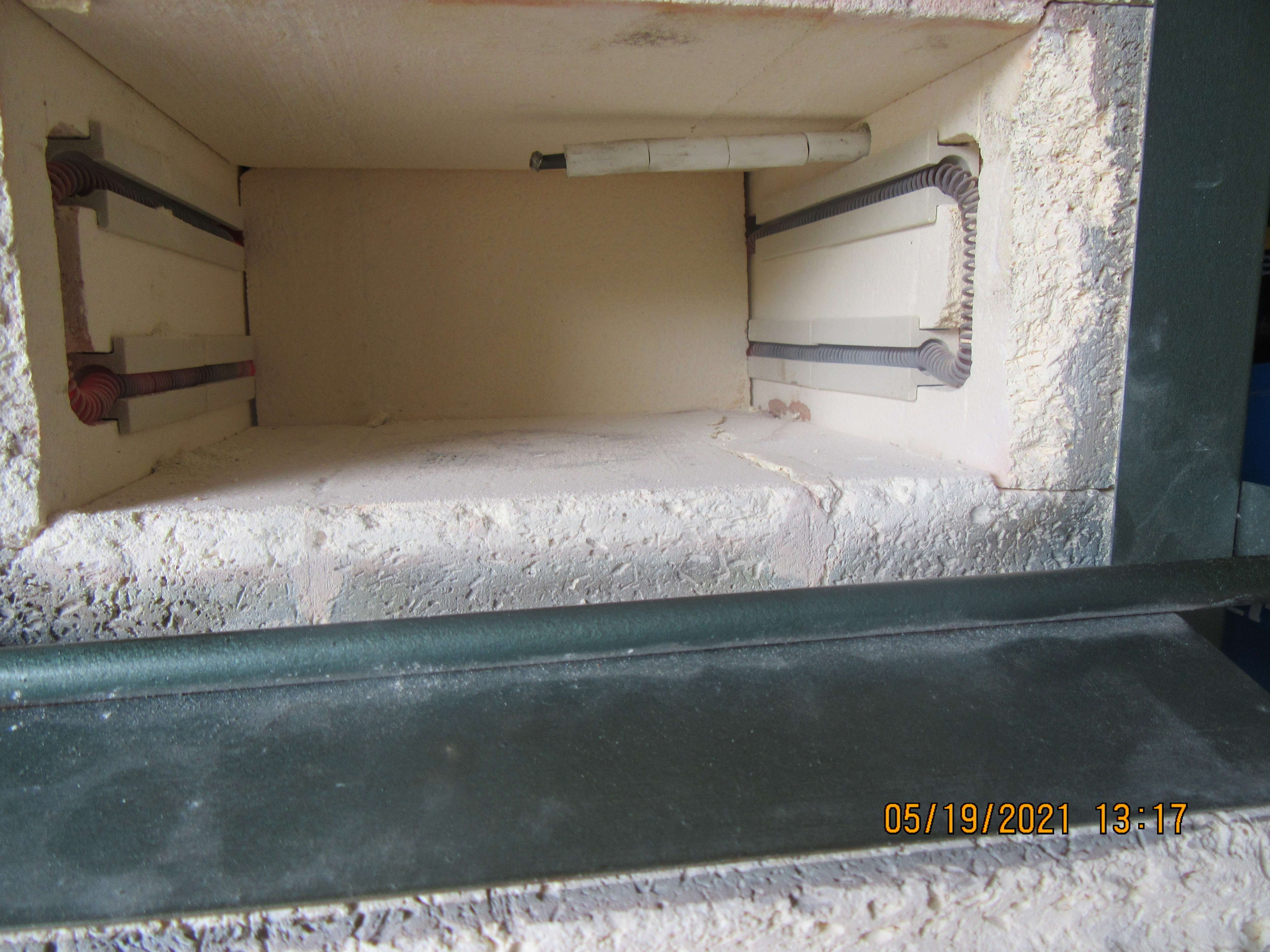



HennieL
Well-Known Member
Well done Brian 


Have you tried to adjust the PID as I suggested in post #43? Curious to know if it works, and shuts off around the 100° setting that is currently showing on the PID (the green SV reading).
Have you tried to adjust the PID as I suggested in post #43? Curious to know if it works, and shuts off around the 100° setting that is currently showing on the PID (the green SV reading).
BaronJ
Grumpy Old Git.
Brian, that hole in the door is supposed to be a viewing port and should have a high temperature glass window in there. If you don't want it put a plate over the hole and stuff some insulation in it.
HennieL I haven't tried anything on the controller yet. Saving that exercise for tomorrow. Tomorrow I will take a run at the controller and see about making better hinges for the oven door.---Brian
willray
Well-Known Member
That hole in the door is supposed to be a viewing port and should have a high temperature glass window in there. If you don't want it put a plate over the hole and stuff some insulation in it.
Not to be too contrary, but I don't think I've seen such a thing on a kiln. All of the kilns I've worked with (admittedly, only 6 or so) have either little (usually cast iron) doors pivoted from a simple screw above the peephole, or, they use kiln plugs:
< Skutt Peephole Plugs | BLICK Art Materials >
willray
Well-Known Member
Regarding your thermocouple installation:
Of course you know heat rises - there's only so much you can do about thermocouple position in a small chamber like that, but you might be surprised at how much difference there can be between the top and the bottom of the chamber. Don't be surprised if you need to make some tweaks to temperature controller settings to produce "correct" temperature set point results.
Another possible cause of consternation (or not, if your controller is actually designed for this) - most of the heat transfer in your oven will be radiative, and your exposed thermocouple will experience exactly the same phenomenon that you observe when you discover that the black fender on your car is blistering-hot to the touch on a sunny day, even though the air may be cool, or is chilly-cold to the touch on a cloudless balmy night.
The thermocouple sheath/thermowell device that HennieL shows is not simply there to protect the thermocouple from the atmosphere, but also to shade it so that it responds more accurately to the kiln's temperature rather than to the elements' temperature. If your controller expects a shielded thermocouple, you may have to play with your controller a bit to get it to behave well.
Neither are show-stoppers by any stretch of the imagination - just things to keep in mind if things don't seem to go quite by-the-book when you start it up.
Best of luck!
Will
Of course you know heat rises - there's only so much you can do about thermocouple position in a small chamber like that, but you might be surprised at how much difference there can be between the top and the bottom of the chamber. Don't be surprised if you need to make some tweaks to temperature controller settings to produce "correct" temperature set point results.
Another possible cause of consternation (or not, if your controller is actually designed for this) - most of the heat transfer in your oven will be radiative, and your exposed thermocouple will experience exactly the same phenomenon that you observe when you discover that the black fender on your car is blistering-hot to the touch on a sunny day, even though the air may be cool, or is chilly-cold to the touch on a cloudless balmy night.
The thermocouple sheath/thermowell device that HennieL shows is not simply there to protect the thermocouple from the atmosphere, but also to shade it so that it responds more accurately to the kiln's temperature rather than to the elements' temperature. If your controller expects a shielded thermocouple, you may have to play with your controller a bit to get it to behave well.
Neither are show-stoppers by any stretch of the imagination - just things to keep in mind if things don't seem to go quite by-the-book when you start it up.
Best of luck!
Will
After what seemed to be an incredible lot of faffing about, I have the oven controller operating, holding the oven at a constant 1100 degrees Fahrenheit. I may want to tighten up the parameters, (its cutting off power at 1130 degrees and restoring power at 1020 degrees. I will search about in my instructions and see if there is a way to do that.
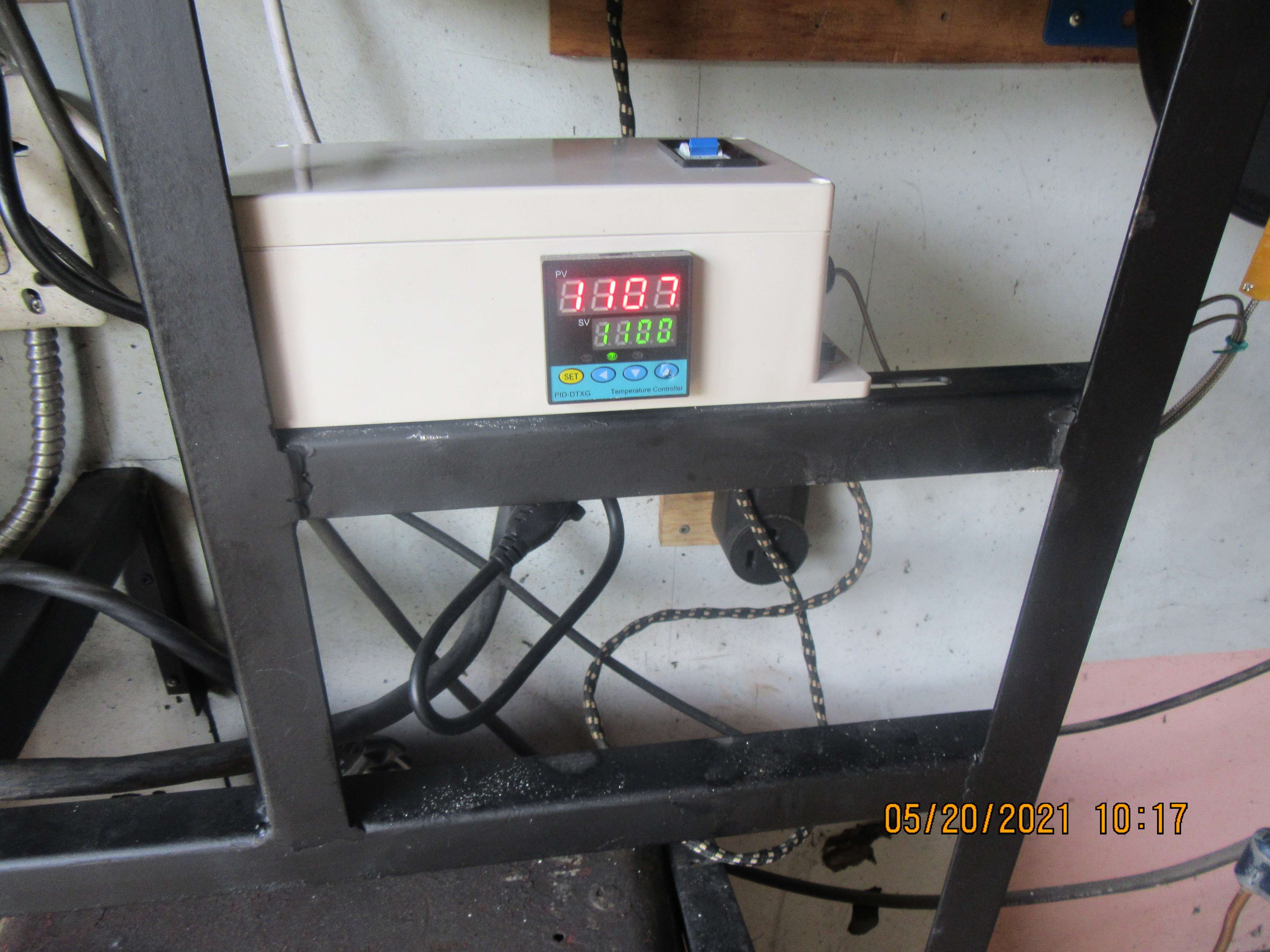

HennieL
Well-Known Member
Congrats, Brian - now you're getting there.
I suggest you now run the "Auto tuning" function of your PID. The below is an extract from the manual that I emailed to you, and lists the steps. The two documents that I sent to you differ a bit - typical of the Chinese documentation, and I'm not 100% sure which one would be fully applicable to your unit, but I suggest you try the following:

I really hope this works for you - unfortunately, not being able to look at your PID while you're running through the program steps, there is a (slight) risk that it might not respond as I'm used to my PID's responding, but even if it does not auto tune correctly, you will still be able to change each individual parameter back to it's factory setting, so no great risk here...
Good luck
I suggest you now run the "Auto tuning" function of your PID. The below is an extract from the manual that I emailed to you, and lists the steps. The two documents that I sent to you differ a bit - typical of the Chinese documentation, and I'm not 100% sure which one would be fully applicable to your unit, but I suggest you try the following:
- Start with your oven cold the the "SV" value set to your 1100°F
- Press the "Set" button for at least 3 seconds - the unit will then enter it's "programming" mode.
- Following the program steps in the image posted below, repeatedly press and release the "Set" button, checking to see if the menu follow that on the left hand side of the image - starting with "AL 1".
- Keep on pressing and releasing the "Set" button until you reach the "Auto tuning switch" depicted with either "Aru" or "At" on the display. According to the manual this should be the 3rd push of the button, but depending on the unit's security settings it could perhaps be only after the 10th button push.
- Don't push any other buttons except for the "Set" button until you reach the "Auto tune" function, else you might inadvertently change something else.
- When you reach the "Auto tune" function, press the sideways arrow button once to enter this function.
- Check the display, and confirm that the value now shows either "0" or "off". Press either the up or down arrow to change this value to either "1" or "on".
- Press the set button to exit this function.
- If the "Auto tune" led does not light up and the oven does not switch on, press the "Set" button a second time, keeping it pressed for at least 3 seconds - it should then start.
- Leave the oven to cycle on and off for some time (could take hours...) until it finally switches off on it's own - the auto tune function would then have switched off, and your PID should now be "tuned" for your oven.
- If everything went well, it should now have less over- and under-shoot.

I really hope this works for you - unfortunately, not being able to look at your PID while you're running through the program steps, there is a (slight) risk that it might not respond as I'm used to my PID's responding, but even if it does not auto tune correctly, you will still be able to change each individual parameter back to it's factory setting, so no great risk here...
Good luck
I didn't do any more messing around with the controller today. I still have to learn more about it and I've seen that I can get the oven to go to 1100 degrees F and hold it there, which was my biggest question. This oven had the poorest hinge plates on it that I have ever seen. They are only .025" thick material and were bent all to heck. I whittled out some new hinge plates this afternoon from 3/16" aluminum and tomorrow I will concentrate on getting the "door" to fit better and install the new hinge plates.
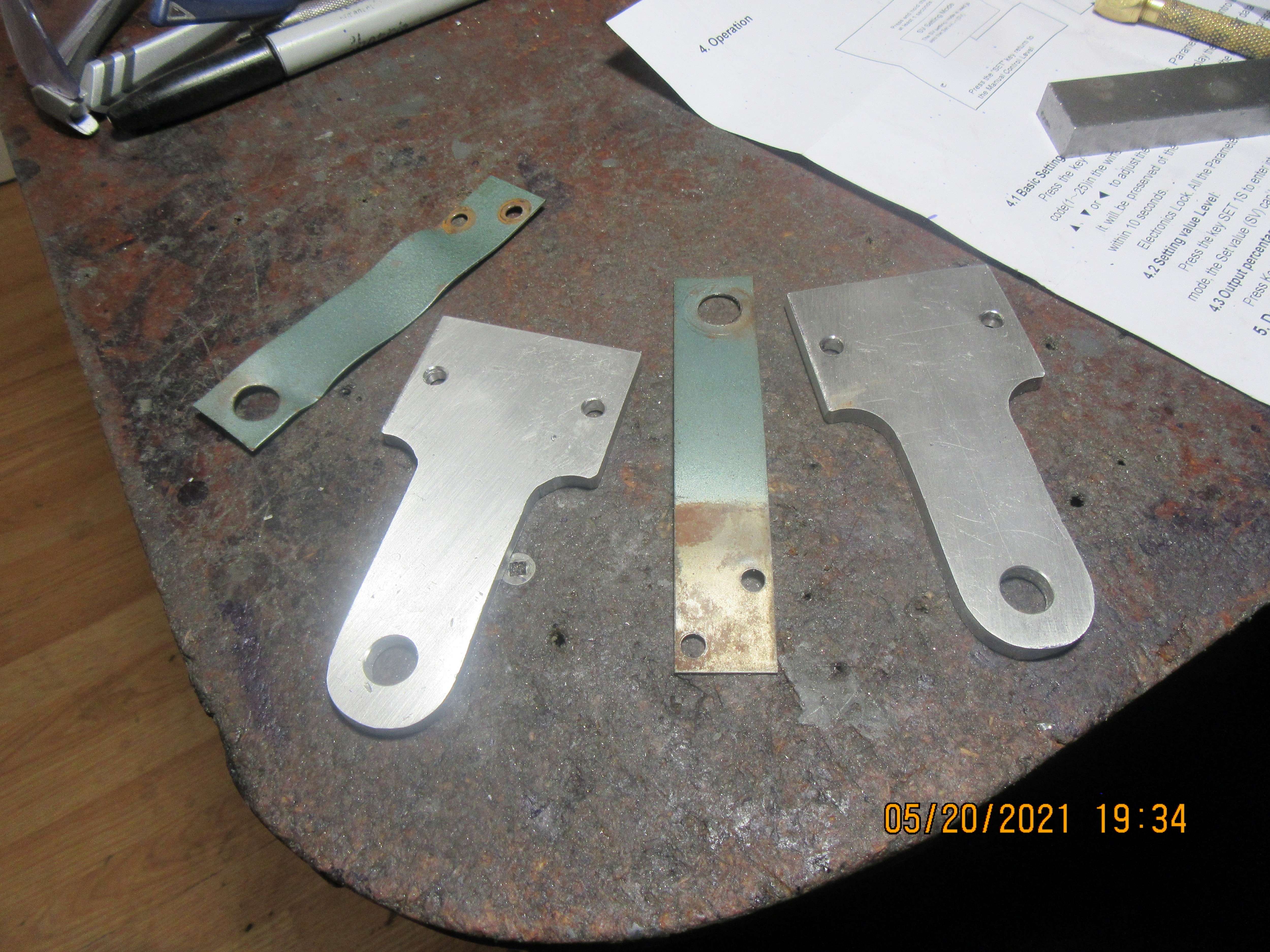

- Joined
- Dec 31, 2010
- Messages
- 813
- Reaction score
- 215
If I can make another suggestion.
The display might be showing 1100deg but can you prove it is??
Pre-heat the oven to one of the temperatures that produce the well known tempering colours.
For instance 282deg C (540def F).
Put a thin piece of very clean steel in the oven and let it soak for an hour or more (depending on the metal thickness). For the temperature mentioned the steel should have turned purple.
You can google the tempering colours. They are very close in temperature and accurate. So you can get your oven tuned very close with those. It will probably come down to the best placement of the thermocouple to accurately sense the real internal temperature.
Don't forget you need to allow a long time at the beginning of a session for the bricks heat to stabilize.
The display might be showing 1100deg but can you prove it is??
Pre-heat the oven to one of the temperatures that produce the well known tempering colours.
For instance 282deg C (540def F).
Put a thin piece of very clean steel in the oven and let it soak for an hour or more (depending on the metal thickness). For the temperature mentioned the steel should have turned purple.
You can google the tempering colours. They are very close in temperature and accurate. So you can get your oven tuned very close with those. It will probably come down to the best placement of the thermocouple to accurately sense the real internal temperature.
Don't forget you need to allow a long time at the beginning of a session for the bricks heat to stabilize.
With respect, one of my main drivers to buy an oven is that I'm not really able to tell temperature by colour. 'Halfway between cherry-red and tomato-red as observed in an old dark and smoky smithy' is way beyond my skills. It is remarkable therefore to see the suggestion to use colours to check the temperature of an oven. The only comparative check I do once in a while is to put a piece of aluminium in the oven and set the temperature just over its melting point. If it then melts I consider the temperature indication to be OK.
willray
Well-Known Member
With respect, one of my main drivers to buy an oven is that I'm not really able to tell temperature by colour. 'Halfway between cherry-red and tomato-red as observed in an old dark and smoky smithy' is way beyond my skills. It is remarkable therefore to see the suggestion to use colours to check the temperature of an oven.
In all fairness, dsage's suggestion was to use the tempering colors rather than the black-body radiation colors as a cross-check.
In addition to tempering colors, and going up to temperatures considerably above the canonical steel tempering colors, there are these neat temperature-check crayons available:
Tempilstik
A handful of these that span your desired temperature range, and you can scribble on a piece of steel and then simply look to see which ones melted and which stayed "crayon gritty", to learn what temperature different parts of the kiln achieved.
... and also, do be aware of that radiative heating issue - a surface that "sees" the elements will heat much faster, and be a lot hotter, than a surface that is shaded from the elements. This makes getting some geometries all to the same (similar) temperature, a real challenge. Sometimes you need to intentionally put "shade walls" up on the sides of your part so that none of it can directly see the elements...
Similar threads
- Replies
- 3
- Views
- 328
- Replies
- 61
- Views
- 13K
- Replies
- 6
- Views
- 923
- Replies
- 40
- Views
- 9K












































![TurboCAD 2020 Designer [PC Download]](https://m.media-amazon.com/images/I/51UKfAHH1LL._SL500_.jpg)








![MeshMagic 3D Free 3D Modeling Software [Download]](https://m.media-amazon.com/images/I/B1U+p8ewjGS._SL500_.png)


